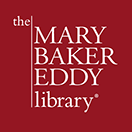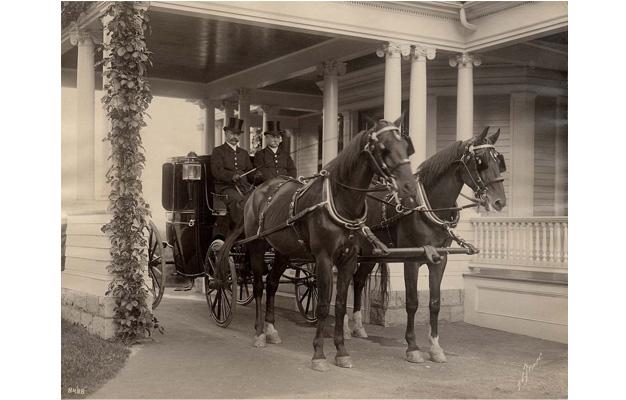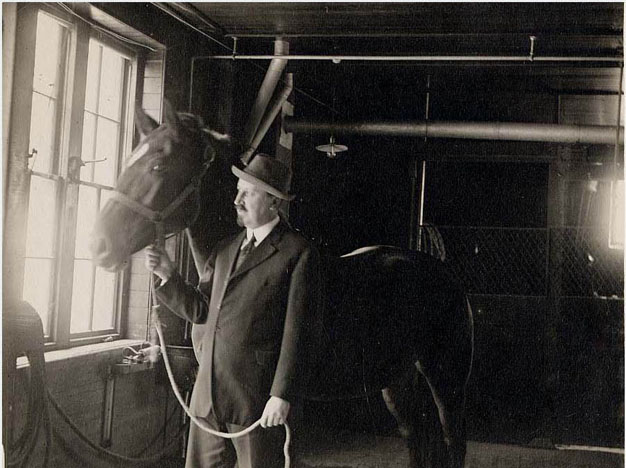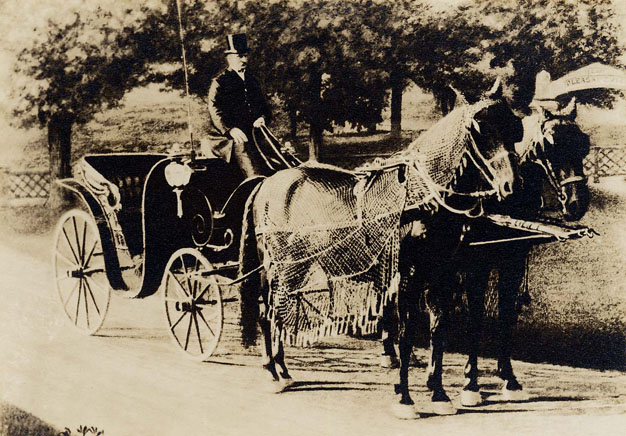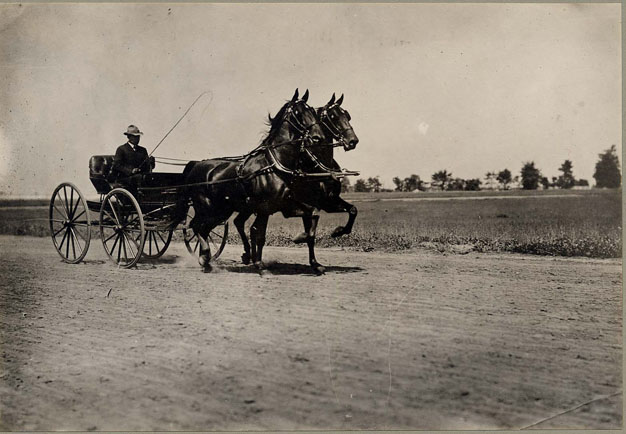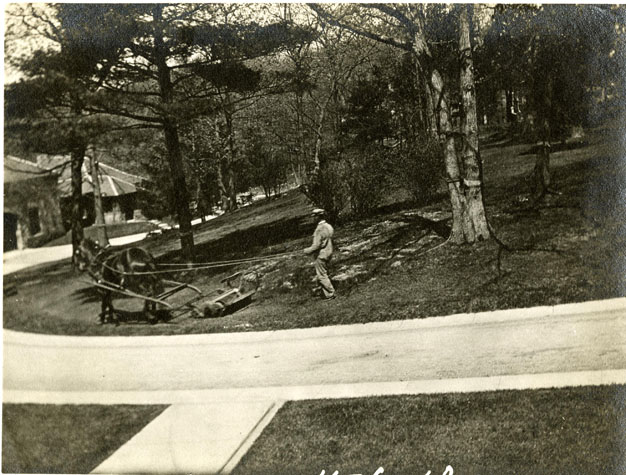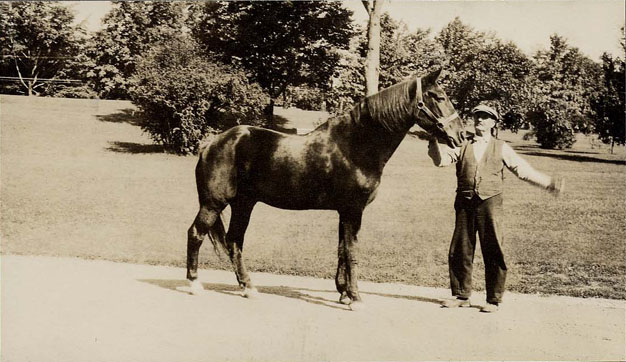August Mann (left) and Calvin Frye (right) driving Prince and Duke at Eddy’s Pleasant View Home, P06537
From a very young age, Mary Baker Eddy loved horses. Years later she recalled calming her father’s work horses as a child, and always found the quiet, gentle rocking motion of a carriage ride to be a comfort. “I have uttered some of my best prayers in a carriage,” she told William Rathvon in November 1910.1
At Pleasant View, her Concord, N.H. home, Eddy kept several different horses. The first horse we find recorded was a black gelding named Captain, purchased in April 1892 for a total of $300, a sum that included his harness.
In the intervening years, we know that she kept workhorses named Jerry, Nelly, and Jean, whose general purpose was to pull plows, wagons, and other farm implements. Jerry and Jean also occasionally pulled the carriage, as we learn from Clara Shannon’s reminiscence:
When she returned from her drive and got out of her carriage she would often go to the end of the verandah nearest to the horses’ heads, and speak to each one. Jerry was nearer to the verandah than Jean, and she would pat his neck or face and speak to him, and then Jean would put his head up over Jerry’s neck, as if he were afraid of being left out, and then she would speak to him. It was very beautiful to me to see her tenderness and love to these horses, and when she came out to get into the carriage they seemed to recognize her each time.2
Over the summer of 1898, Eddy maintained a short, frustrated correspondence with L.E. Currier, who was evidently a local horse dealer. Currier sent her several teams (Eddy often called them “spans”) of black and bay horses that were wholly unsuitable—too young, untrained, skittish, or lame.
In November 1898, Calvin Frye wrote to James Neal, asking him for a recommendation for a good team of carriage horses for Eddy. Within a week, Neal had brought her a pair of matched bay geldings named Prince and Duke. In writing her thanks to Neal, Eddy said “I expect to be an Arab in the love of my steeds.”3
John Salchow arrived at Pleasant View in January 1901, and served as a handyman and caretaker of Eddy’s horses until her passing in December 1910. In his reminiscence, he wrote fondly of Prince and Duke:
Duke was a very intelligent and trustworthy animal, much more so than Prince. I remember that when I had him out in the washroom he would take the hose right out of my hand and hold it in his mouth, trying to drink from it.4
Eddy herself wrote a description of Duke in 1899, when it looked like Prince might be permanently lame and would need to be replaced. “This is the description of Duke: weight 1150 lbs., height 16 hands, color light bay, black mane and tail. 1100 lbs. is better than more in weight for a good traveler. Be sure to have no blemish or difficulty with his limbs, and above all have him kind not one bit skittish or afraid of the cars or anything else.”5
In the end, Prince recovered, much to Eddy’s relief; she wrote that “no animal can ever suit me better than dear Prince.“6
In the spring of 1904, Prince and Duke were retired in favor of a pair of matched black mares named Dolly and Princess, purchased for Eddy by Gilbert Carpenter on April 5. Dolly did not stay long and was replaced by a black gelding named Major. (Some records indicate that Major was by breeding a Morgan. Based on their conformation and the prevalence of the breed in New England at the time, it seems likely that most of Eddy’s carriage horses had at least some Morgan blood in them.)
Eddy’s horses always received exceptional care. In the image above of Dolly and Princess, we can see the fly sheets they wore in the summer to keep them comfortable, as well as the blinkers that were commonly used then and still are today to keep them focused on their jobs. John Salchow also writes of the high standards of horsemanship that Eddy insisted on:
She was very fond of her horses and saw to it that they had the best of care. It is true that they wore blinders and a checkrein, but in those days it was felt that a horse kept his mind on his business better with blinders on and was therefore easier to drive. Mrs. Eddy would never have permitted a high checkrein. Her horses’ heads were only checked sufficiently to hold them in a normal position.7
(Those who have read the novel Black Beauty may remember that the checkrein was often mentioned by Beauty as a particular cruelty. A checkrein, also called a bearing rein, is a strap of leather that goes over a horse’s head or along the line of its jaw. The rein can be tightened, and used to keep the horse’s head at a high, unnatural, fashionable, angle, sometimes as much as 90 degrees to its body. If the rein is kept loose, it serves only to prevent the horse from jerking its head down suddenly, and thus serves a safety function. All of the pictures of Eddy’s horses in harness confirm that the checkrein was thoughtfully adjusted—indeed, nearly slack.)
Eddy was so strongly identified with carriage rides and beautiful teams of horses that sometimes Christian Scientists took it upon themselves to give accoutrements for her carriage, or even new teams of horses. One such gift was sent by T.L.L. Temple of Arkansas; Eddy was so pleased with them that her secretary Lewis Strang wrote in thanks, “I will tell you for your own pleasure that if there is anything Mrs. Eddy enjoys it is a beautiful horse, and she was delighted with your kindness from the first.”8
Eckersall and Tattersall (as the matched bay pair were called) proved to be entirely too skittish to safely pull Eddy’s carriage, however; August Mann, her regular coachman, took them out for a test drive and quickly determined that they were unsuitable. Somehow, rumors spread that the pair had badly frightened Eddy, and newspapers reported with a smirk that perhaps the shock had proved too much for her. A flurry of letters went out from Pleasant View asserting the falsehood of this statement, and the papers had to print corrections.
By the time of her Chestnut Hill years (1908-1910), Eddy kept only one team of horses, Major and Princess, and they occasionally doubled as single-carriage horses or work horses around the property in Chestnut Hill, MA. In mid 1909, a new dark bay mare named Nellie was added; in the picture above, she is driven by Nelson Molway and pulling the lawnmower.
The last of Eddy’s horses, Major, passed away in October 1928 after enjoying a long, well-deserved retirement. The above picture was taken when he was nearly thirty, in beautiful condition, and having far outlived the average horse of his day thanks to superb care.
The dozens and dozens of photographs of Eddy and her horses in the Library collections, as well as the frequent mentions of her horsemanship in reminiscences, prove how important horses were to her. Major’s beautiful condition and keen eye show his beloved status.
